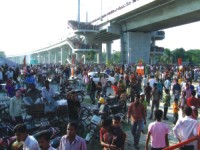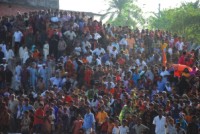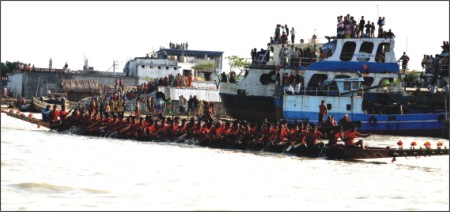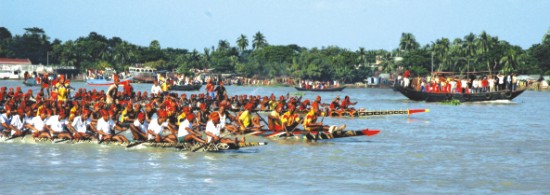|
Photo Story
Racing the Rupsha
Nader Rahman
Photos: Mohammad Firoj Alom Khan

 Boat races or Noka Baicha are an integral part of Bangladeshi culture, in a country dominated by numerous rivers and susceptible to flooding at any given time, boats unlock the choked arteries of our rivers. Boat races in Bangladesh are usually colourful affairs with teams from all over country taking part and this year's Annual Boat Race Competition was no different. With Banglalink as the title sponsors there was a tremendous amount of publicity leading up to the event, which after many years caught the imagination of the public. Boat races or Noka Baicha are an integral part of Bangladeshi culture, in a country dominated by numerous rivers and susceptible to flooding at any given time, boats unlock the choked arteries of our rivers. Boat races in Bangladesh are usually colourful affairs with teams from all over country taking part and this year's Annual Boat Race Competition was no different. With Banglalink as the title sponsors there was a tremendous amount of publicity leading up to the event, which after many years caught the imagination of the public.
 The race was held in Khulna on the Rupsha river on 27 October amidst much fanfare and excitement. The Nagar Shamajik O Sangskritik Kendro (Urban Social and Cultural Centre) organised the event with the backing of the title sponsors and even they did not expect such a massive response from the local people. They estimated that anywhere between 10 to 15,000 people would show up to watch the race, but they underestimated the figures badly as close to 100,000 showed up to watch what would be people the largest attended boat race in recent history. Spectators crammed both banks of the river and piled on to hundreds of viewing boats on the very edge of the racing line to watch around 30 teams from Gopalganj, Narail, Jessore, Bagerhaat, Saatkheera and from various upazillas of Khulna District. The race itself was divided into three heats before a winner could be decided and the teams participating put up a brave show for the spectators. The boats themselves were under 50 feet long with narrow bodies painted in bright colours and with more than 50 people per boat, when everyone was on and rowing the weight of the oarsmen often put most of the lightweight boat under water, thereby making the process of rowing that much harder. The race was held in Khulna on the Rupsha river on 27 October amidst much fanfare and excitement. The Nagar Shamajik O Sangskritik Kendro (Urban Social and Cultural Centre) organised the event with the backing of the title sponsors and even they did not expect such a massive response from the local people. They estimated that anywhere between 10 to 15,000 people would show up to watch the race, but they underestimated the figures badly as close to 100,000 showed up to watch what would be people the largest attended boat race in recent history. Spectators crammed both banks of the river and piled on to hundreds of viewing boats on the very edge of the racing line to watch around 30 teams from Gopalganj, Narail, Jessore, Bagerhaat, Saatkheera and from various upazillas of Khulna District. The race itself was divided into three heats before a winner could be decided and the teams participating put up a brave show for the spectators. The boats themselves were under 50 feet long with narrow bodies painted in bright colours and with more than 50 people per boat, when everyone was on and rowing the weight of the oarsmen often put most of the lightweight boat under water, thereby making the process of rowing that much harder.

The event was truly one of a kind as large segments of people supporting their teams cheered wildly from start to finish, and what a place to finish it was. The race ended at the impressive Khan Jahan Ali Bridge, commonly known as the Rupsha Bridge. It was supposed to be a low-key event with a little dash of local flavour and it turned into a mega event of national importance. The sight of 50 men rowing in sync, pushing their bodies to their very limits as the sun set in the background is truly an image to remember.


Copyright
(R) thedailystar.net 2007 |
